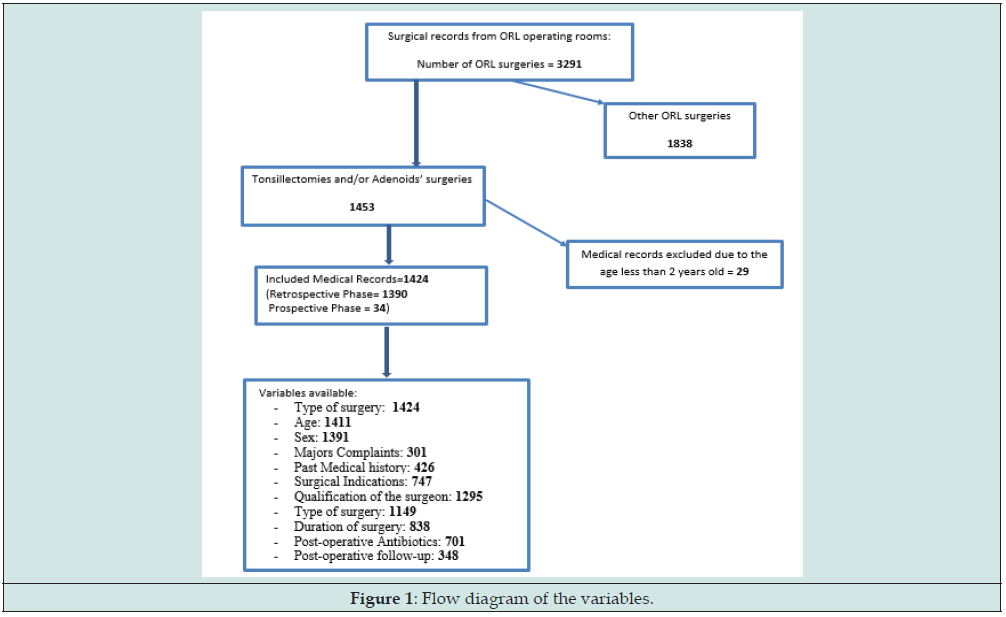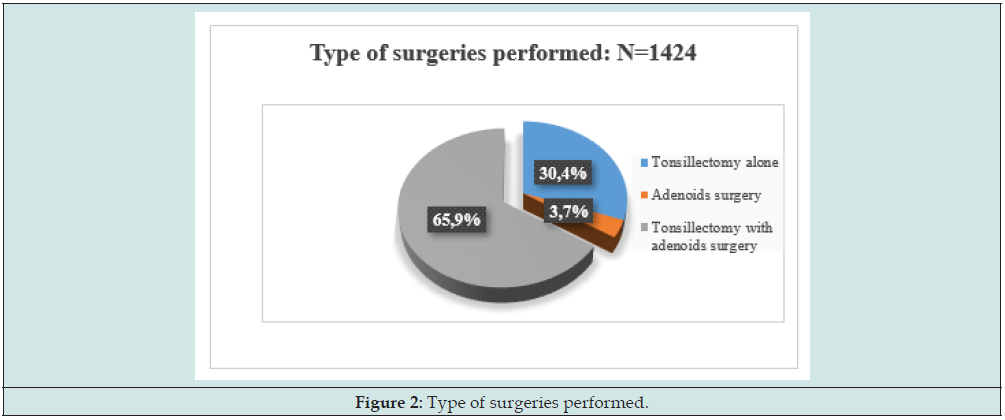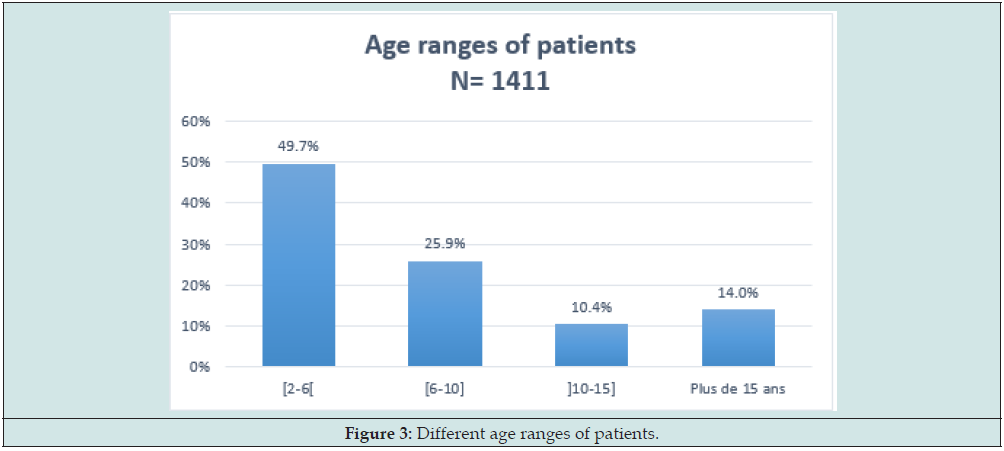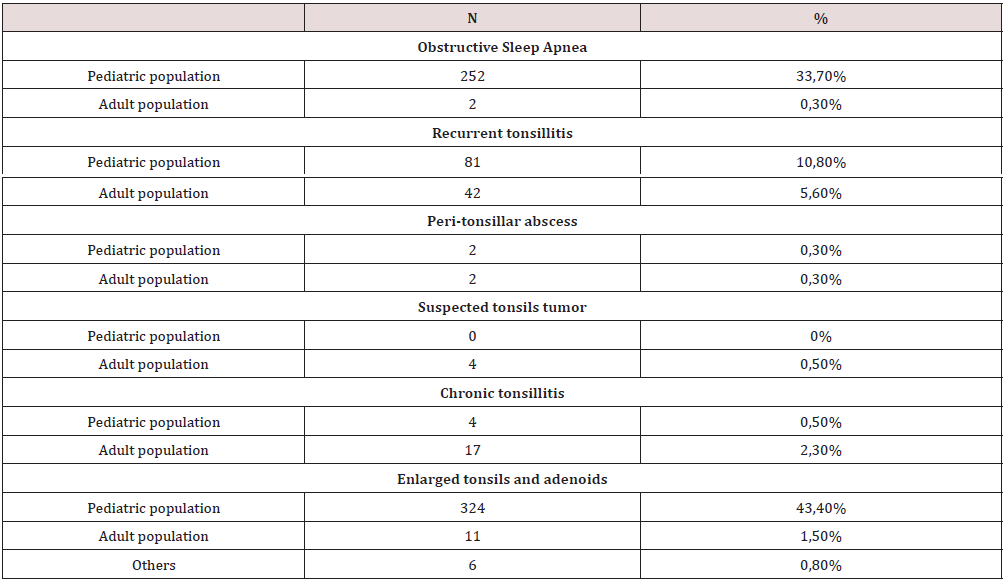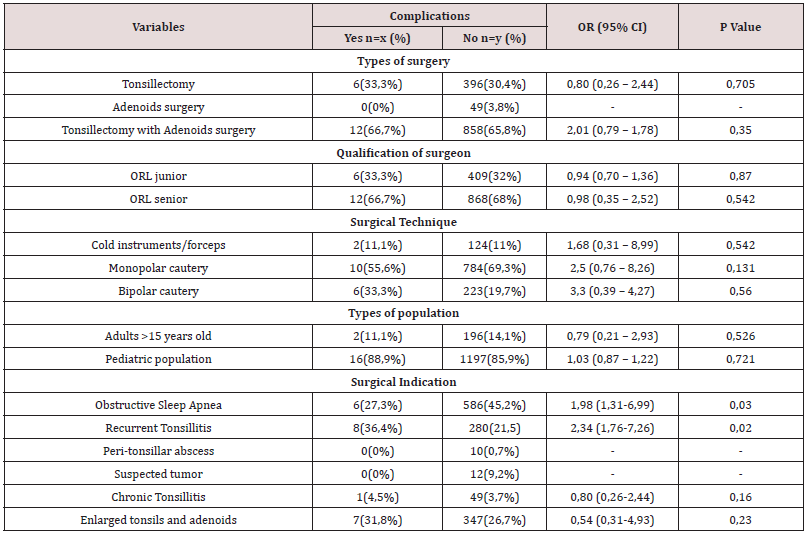
Lupine Publishers Group
Lupine Publishers
Menu
ISSN: 2641-1709
Research Article(ISSN: 2641-1709) 
Tonsillectomy and its Complications in A Low- and Middle- Income Country Volume 9 - Issue 4
Antoine Bola Siafa1*, Yves Christian Andjock Nkouo1, Emmanuel Choffor Nchinda1, Brenda Koungoum Neh Tchinde2, François Djomou1 and Louis Richard Njock1
- 1MD, ORL Surgeon, Department of Ophthalmology, Otolaryngology and Stomatology, Faculty of Medicine and biomedical Sciences, University of Yaounde I, Cameroon
- 2MD, Department of Ophthalmology, Otolaryngology and Stomatology, Faculty of Medicine and biomedical Sciences, University of Yaounde I, Cameroon
Received: January 06, 2023; Published: January 20, 2023
Corresponding author: Bola Siafa Antoine, Department of ENT and Head and Neck Surgery, Yaounde University Teaching Hospital, PO Box 1364 Yaounde
DOI: 10.32474/SJO.2023.09.000318
Abstract
Introduction: Tonsil surgery is a common procedure in otolaryngology and may be associated with complications. Its indications have evolved and are well codified. In the literature, obstructive and infectious indications remain the most common ones. In Africa, there is little data on the annual number of tonsil surgeries performed. Although these are routine procedures in ORL. We proposed to evaluate the practice of this surgery in our context.
Objectives: The objective of this study was to assess the practice of tonsil surgery and its complications in the five teaching hospitals of Yaounde the city capital of Cameroon.
Methodology: A descriptive cross-sectional study was conducted in the ENT units of five teaching hospitals in Yaounde. The targets were patients who underwent tonsil surgery from January 2015 to March 2021. The variables studied were qualitative: gender, reason for consultation, history, indication, type of intervention, surgical technique, surgeon’s grade, and complications but also quantitative: age, operative time. The SPSS (statistical package for social sciences) software version 21.0 was used for statistical analysis.
Results: A total of 1424 tonsil surgery records were obtained representing 44.1% of the ORL surgical activity in Yaounde during the study period. The mean age was 9.05 years old with a median age of 6. The most represented population was the pediatric population (p=0.012). The main indications for surgery were enlarged tonsils and adenoids (44.9%), obstructive sleep apnea syndrome (34%) and recurrent tonsillitis (16.4%). Tonsillectomy with adenoids surgery was the most performed surgical procedure (65.9%) (p=0.026) and extra capsular dissection with monopolar cautery was the most used technique (69.1%) (p=0.0). Hemorrhage was the main complication observed and represented 3.16% of cases. No significant association was found between the occurrence of complications and the type of surgery, the qualification of the operator, the operative technique and the type of population, however, there was a statically significant association between the occurrence of complications and the indications obstructive sleep apnea syndrome and recurrent tonsillitis.
Conclusion: Tonsillectomy is a common ORL surgery in Yaounde. The indications are classical. The techniques are diversified and the complications, when they exist, they are mainly bleeding.
Keywords: Tonsillectomy; adenoidectomy; Complications; Practice; Yaounde
Introduction
Tonsillectomy is defined as a surgical procedure consisting of a complete or partial (tonsillotomy) removal of one or the two tonsils. It is often associated with the removal of adenoids during the same operating time [1]. It is indeed a common procedure in otolaryngology (ORL) practice and among the first surgical interventions taught to ORL residents during their residency training program [1]. That procedure has been practiced for more than 2000 years. The first indications for tonsillectomy were probably relative to repeated throat infections leading to peritonsillar abscess [2]. The number of tonsils surgeries started to drop after the sixties due to the discovery of antibiotics and their role in the management of tonsillitis. From 1960 to 1970, up to 2 million tonsillectomy surgeries were performed in the USA every year, nowadays less than half of these surgeries are done annually in the country [2]. Tonsillectomy is often mistaken as a “minor” surgery. One has to be aware that it can be associated with life threatened complications if all necessary measures are not taken during the procedure.
In France, the number of tonsillectomies has also been dropping since 2010 and the overall mortality ratio is estimated at 1 out of 50,000 [3] tonsillectomy surgeries. In Sub Saharan African countries, the number of tonsillectomies is probably underestimated due to the lack of studies done on that particular topic. What is known for example is the fact that tonsillectomies represent 10% of all ORL surgeries in Burkina Faso [4] and 29.7% in Côte d’Ivoire [5]. In Cameroon, since the opening of a residency training program in Otolaryngology and head and neck surgery at the Faculty of Medicine and Biomedical Sciences of the Yaounde I University in 2007, tonsillectomy has also been the first surgical intervention taught to ORL residents. But less is known about the practice of tonsillectomy and its complications. Many surgical techniques are used according to the age of the patients, the indication of tonsillectomy whether it is associated with adenoids surgery or not, and the availability of technical platforms in the different teaching hospitals. To the best of our knowledge, only a few studies have been conducted on tonsillectomy in Cameroon and more especially on its complications. This is why we decided to carry out a research on this surgical intervention in five teaching hospitals of Yaounde, in other to assess that practice and eventually the complications generated from tonsillectomy surgeries.
Methods
Study design
It was a cross sectional study. The recruitment was retrospective from January 2015 to December 2020 on patients’ records; and prospective from January 2021 to March 2021.The study was a multicentric one, involving five departments of ORL and Head and Neck Surgery in five Teaching Hospitals located in Yaounde the city capital of Cameroon. Those hospitals were: The Yaounde University Teaching Hospital, The Yaounde General Hospital, The Yaounde Central Hospital, The Yaounde Gynecologic and Pediatric Hospital and the Yaounde Insurance Medical Center.
Patients
All patients operated for tonsillectomy and/or adenoids surgery in the 5 teaching hospitals from January 2015 to Mars 2021 were targeted by the study. For the first part of the recruitment (retrospective) we extracted data from medical records of the patients if they were available after having obtained informed consents from the patients and/or their parents or legal tutors through a phone call. For the second part (prospective) we did seek for informed consents before the surgery and then extracted data from patient records after having attended their surgeries. All patients less than 2 years of age and patients who refused to participate to the study were excluded.
The sample size was calculated using the Cochrane formula (N=P(1-P)*T2/m) and according to a prevalence of tonsillectomies (28.36%) from a previous study done in Yaounde [6], we could estimate a minimum sample size at N=312 patients.
P: prevalence, T: Confidence level (1.96) from a 95% confidence interval, m: error (5%).
Procedure
After the authorization from the ethical review board (ERB) of the faculty of medicine and biomedical sciences (FMSB/UY1 0051/ UY1/FMSB/VDRC/DAASR/CDS), we sought and obtained administrative authorizations from the directors of all the 5 teaching hospitals. We started from the surgical registers in different operating theaters, in order to identify all patients who underwent tonsillectomy surgery during that period. Then from there, we could trace their medical records in different ORL departments of the 5 hospitals. For the prospective part, the patients’ lists were obtained directly from the concerned ORL department. Then, the data were extracted from the medical records but also from the anesthesiologist forms.
Variables
We analyzed: The personal data of the patients (age, sex, past medical history), the indications of the surgery, the type of surgery performed and the technique used (tonsillectomy alone or associated with adenoids surgery, adenoids surgery alone), the qualification of the surgeon (ORL Resident or junior surgeon; senior surgeon meaning with more than 5 years of practice), the duration of the procedure (operation’s time), any antibiotics prescribed during the post-operative period and the post-operative follow-up (with or without complication(s) due to the surgery). All data were then analyzed using SPSS software (2021 version). Qualitative variables were represented in percentages, graphs and tables. Quantitative variables were summarized in means, standard-deviations and modes. X2 was used to calculated OR and the 95% confidence intervals, the statistical significance of tests was estimated with a P value of less than 5%.
Ethical issues
Authorizations were obtained from the ERB of the Faculty of Medicine and Biomedical Sciences of the University of Yaounde I. The informed consents were signed or given orally by the participants and/or their parents or legal tutors. All the data were anonymized and used only for the purpose of this study.
Results
During the two phases (retrospective and prospective) of the recruitment, 1453 medical records were eligible for the study but only 1424 were included (Figure 1).
Frequency of tonsillectomy
During the study period, 3291 ORL surgeries were performed in these teaching hospitals. 1453 tonsillectomies and/or adenoids surgeries were done out of these 3291 cases. Giving a proportion of 44.1%. Tonsillectomy and/or adenoids surgery represented almost half of all the ORL surgeries in Yaounde during that period. Three types of surgical interventions: Tonsillectomy (30.4%), Tonsillectomy with adenoids surgery (65.9%) and adenoids surgery alone (3.7%) were recorded during the study with tonsillectomy with adenoids surgery being the most common one (p=0.026) as shown in Figure 2.
Patients personal and anamnestic data
Age: The mean age was 9.05 (+/-9.11) years old with a median age of 6 years old.
The most common age range was from [2-6[ years old (49.7%) with a p value=0.17. The different age ranges are displayed in Figure 3; 86.6% of all patients were aged 15 years old or less (p value= 0.012).
Sex: On the 1391 records where sex was mentioned, 49,64% were female and 50.36% males, giving a sex-ratio of 1.01 for males (p value= 0.8).
Major complaints: 301 medical records had this variable. The most common complaints were:
Snoring (33.2%), throat pain or odynophagia (16.6%), difficulties breathing (15.6%), mouth breathing (12.6%), dysphagia (4.3%) and Hyper sialorrhea (3.3%).
Past medical history: Tonsillitis (76.3%) was the most common past medical history from the 426 medical records analyzed for that variable (p=0.67).
Patients’ clinical data
I. Indications of surgery
747 records were available for this variable. The indications for surgery were:
a) Enlarged tonsils and adenoids: 44.9%
b) Obstructive sleep apnea: 34%
c) Recurrent tonsillitis: 16.4%
The Table 1 displays the population (adult and pediatric) according to the indications.
Qualification of the surgeon
68% of the surgeries were done by senior surgeons (with at least 5 years of experience), the remaining cases were operated by junior surgeons or final year ORL residents (p= 0.03) as displayed in Figure 4.
Type of surgical procedure
Data was available from 1149 medical records. The surgical procedure commonly used in this study was extra capsular dissection with monopolar cautery (69.1%) followed by bipolar cautery (19.9%) and the cold instruments technique (11%) p value=0.000.
Duration of surgery: The mean operating time was 44 minutes (+/-28) with a median time of 38 minutes.
Post-operative antibiotics: Of the 701 medical records analyzed for this variable, 69% of patients received antibiotics after surgery (p=0.32).
Complications
This variable was assessed in 348 medical records. 18 complications (5.17%) were noted:
a. 11 cases of bleeding (3.16%), 2 during the surgical procedure and 9 in post-operative period. Among these post-operative bleedings, 4 were noted more than a week after the surgery.
b. 7 cases of: persistent dysphagia (3), persistent throat pains (3) and 1 case of voice modification.
We also checked if there was any association between the presence of complication and the other variables as shown in Table 2. We found that the indications: obstructive sleep apnea and recurrent tonsillitis were associated with complications.
Management of complications
64.7% of the complications were treated medically using ice and some IV hemostatic medicine for patients with mild bleeding. We also added iron medicines in case of anemia due to bleeding.
11.8 % (2 patients) of the patients with complications (bleeding) were brought back to the operating room to stop the bleeding. One patient (a nine-year-old girl) was transfused and received one pint of total blood.
Discussion
The main objective to this study was to assess the practice of tonsillectomy and eventually the complications associated with this procedure in the five teaching hospitals of Yaounde the Cameroon’s city capital. About 1453 patients were operated on for tonsillectomy and/or adenoids surgery during that period of time, representing 44.1% of all ORL surgeries. The mean age was 9.05 (+/-9.11) years old with a median at 6 years old. The pediatric population (Patients less than 15 years old) was the most common one (p=0.012). Concerning the indications for surgery: Enlarged tonsils and adenoids (44.9%) were the most common followed by Obstructive sleep apnea (34%) and recurrent tonsillitis (16.4%). Tonsillectomy associated with adenoids surgery was mainly performed and the monopolar cautery dissection was the surgical technique mostly used by surgeons in this research. Bleeding was found to be the major complication and represented 3.16% of the surgeries. The limitations of this study are due to its retrospective phase associated with incomplete medical records and unavailability of some data and the bias toward the teaching hospitals of Yaounde. There are other hospitals (public and private) in the city capital where tonsillectomy has been practiced by skilled surgeons but most of these surgeries are done in the selected teaching hospitals chosen for the study. The prospective phase, though not long enough (3 months) helped us to have a better picture of our research, complete our data and have reliable information to properly analyze those data.
Frequency of tonsillectomy
Tonsillectomy represented 44.1% of all ORL surgeries, that is half of all the surgical interventions done in ORL but even more it is the most common surgery performed in ORL departments. Djomou et al. in Cameroon (54.06%)7, Illé S et al. [9] in Niger (42.91%)8 and Sy et al. in Senegal (71%) found the same trends. In Sub Saharan Africa, tonsillectomy is still the commonest ORL surgical procedure probably because of the huge number of patients presenting with recurrent tonsillitis but also because (as compared to other ORL surgeries) it is considered as a “kind” procedure in terms of learning process and technical platforms. It does not need a very specialized equipment to be performed and it is affordable for the patients. On the other hand, in developed countries there is a tendency of decreasing the number of tonsillectomy procedures. In France for example, it represents only 10.4% of all ORL surgeries [10], the reason is they have less infection of the throat and their equipment allow them to perform different types of ORL surgeries and not only tonsillectomies.
Sociodemographic data
Age
The mean age was 9.05 years old with a median of 6 years old. It was also found by Djomou et al. in Cameroon7 and Tea et al. in Côte d’Ivoire [5]. The pediatric population (less than 15 years old) represented 86% of the whole population, Illé found 71.03% and Thiam 63.2% [8,11]. Tonsillectomy is commonly practiced in children worldwide and is often considered as a pediatric surgical procedure.
Sex
There was no gender difference between male and female sex in our study like in many studies done in similar contexts [5,7,9]. In west Africa, some studies revealed that more females where operated but despite those findings, there was no significant differences between males and females concerning tonsillectomy [9,11].
Clinical and surgical data
Presenting complaints
Snoring and throat pain were found to be the most common presenting complaints in our study. In Africa and specifically in Cameroon, tonsillectomy is associated with enlarged tonsils and/or adenoids but also with recurrent tonsillitis. Enlarged tonsils and/or adenoids are often responsible of snoring while tonsillitis will lead to odynophagia [7].
Indications of surgery
Enlarged adenoids (44.8%), obstructive sleep apnea (34%) and recurrent tonsillitis (16.46%) were in order of frequency the common indications of surgery. These data are similar to those found by Djomou et al. [7], Njock et al. [12]. Those two authors had in their series the same type of indications for tonsils surgeries. This may be a particularity to Cameroon because we found the same indications, but our sample size was bigger than theirs. In Abidjan5 in the other hand, Chronic tonsillitis was the indication of choice for tonsillitis, this difference can be explained by their definition of chronic tonsillitis but also their guidelines to decide who to operate and when. Another point is the mean age of our population who was younger than the population of Abidjan. Because chronic tonsillitis is associated with older patients as compared to enlarged tonsils and adenoids.
Qualification of surgeon
Most surgeries were performed by senior surgeons, our study was done in 5 teaching hospitals where we have senior surgeons and their students. Most surgeries are done either by senior surgeons or under their supervision through a mentorship process.
Type of surgical technique
The main objectives of all new techniques for tonsillectomy are the reduction of operating time and the control of bleeding. In Sub Saharan Africa, extra-capsular tonsillectomy is the technique of choice with a monopolar cautery dissection. This was also what we found in our series. This is because the monopolar cautery machine is available in all hospitals and most of the surgeons working in these hospitals have been trained to use it. Fewer and less surgeries are done nowadays using only cold instruments.
Operating time
The overall operating time was 43 minutes. This time did not differentiate between the qualification of surgeons, the indications, the type of surgery performed, or the type of instruments used. Tonsillectomy is done in less than one hour nowadays in Cameroon and we think that the time duration will continue to drop according to the learning curve of this procedure by younger surgeons.
Post-operative antibiotics
Post-operative antibiotics after tonsillectomy is not regulated in Cameroon. It is done according to the experience of the surgeons. In this study 69% of patients received an antibiotic after their surgeries. A study done in Douala-Cameroon [13] has shown that the prescription of antibiotics following tonsillectomy should not be mandatory; because there is no evidence of any prevention or protection against a possible surgical site infection [14].
Complications of surgery
18 patients (5.17%) had a complication during our study. Bleeding was the most common one in all studies. Bleeding following tonsillectomy has an incidence of 0.5 to 10% [15]. In our study, 3.16% of patients had a bleeding due to the surgery. Tonsillectomy is often depicted as a bleeding surgery despite the qualification of the surgeon, or the technique used. It is then essential to have an appropriate surgical technique and to closely follow up all patients undergoing a tonsil surgery. Some bleeding can occur during the surgery, directly after the surgery or a few days after the procedure. No matter the case, the team managing a patient for tonsillectomy should be ready to respond very quickly in case of hemorrhage. Our study revealed that two indications (Obstructive Sleep Apnea and recurrent tonsillitis) were associated with complications. Those indications which are among the most common for tonsillectomy in our study should be taken into consideration and a close follow up should be done when dealing with them. Only 2 patients were taken back to the operating room to stop the bleeding. It is also not common to bring back patients to the operating room. Situations like that happen when the bleeding is important and cannot be managed medically.
Conclusion
Tonsillectomy represents a huge amount of ORL surgeries in Yaounde and is mostly done in children of 15 years old or less. Tonsillectomy with adenoids surgery is the most common surgical procedure using monopolar dissection technique. Complications of this surgery are scary and when present they are mainly due to pear or post-operative bleedings. Tonsillectomy should not be considered as a “minor” surgery and the procedure should be well planned in advance if one wants to prevent any adverse effect or complication.
Competing Interests
The authors declare no competing interest.
References
- Nicollas R, Bonneru JJ, Roman S, Triglia JM (2004) Adénoïdectomie- EMC - Oto-rhino-laryngologie 1: 301-317.
- François M (2003) Histoire de l’amygdalectomie. La lettre de l’oto-Rhino-Laryngologie et de la Chirurgie Cervico Faciale pp. 19-21.
- le Bail M, Or Z (2016) Atlas des variations de pratiques mé Recours à dix interventions chirurgicales.
- Dao M, Kabre M, Ouedraogo I, Ouoba K, Sanou A (1997) L’amygdalectomie dans un service d’ORL d’Afrique Noire: à propos de 148 cas au CHU de Ouagadougou. Burkina medical pp. 23-27.
- Téa Z (2011) Profil de l’amygdalectomie à Rev Col Odonto-Stomatol Afr Chir Maxillo fac 18: 48-52.
- Bola Siafa A (2015) Evaluation et prise en charge de la douleur post-opératoire en chirurgie ORL au CHU de Yaoundé. La révue africaine d’ORL et de chirurgie cervico-faciale 15: 53-59.
- Djomou F (2021) Pratique de l’amygdalectomie et de l’adénoïdectomie à Yaoundé. Health Sciences and Disease 22: 56-59.
- Illé S, Djafarou Abarchi B, Kadre Alio K, Timi N, Dan Sono A (2018) Les cellulites cervico-faciales au service d’ORL et de chirurgie cervico-faciale de l’hôpital national de Niamey. Health Sciences and diseases 19: 49-51.
- Sy A, Fofana M, Diandi Y, Diuof-Ba MS, Diouf R (2016) l’amygdalectomie et l’adénoïdectomie à l’hôpital pour enfants de Diamniadio au Sénégal: une évaluation de 3 ans. Health Sciences and Diseases 17: 50-54.
- Senez B, Laugier L (1998) Indications de l’adénoïdectomie et/ou de l’amygdalectomie chez l’enfant. J Pediatr Pueric 11: 104-123.
- Thiam N (2018) Indications, techniques and complications of tonsillectomy and adenoidectomy: Review of 10 years at the Ouokam Military Hospital. African Journal of Surgery 5: 20-26.
- Njock L, Njifou Njimah A, Djomou F, Ndjolo A (2014) Indications actuelles de l’amygdalectomie et de l’adénoamygdalectomie à l’hôpital général de Douala. Health Sciences and Diseases 15: 1-4.
- Essomba E (2013) Efficacité de l’antibiothérapie en post amygdalectomie en Afrique Subsaharienne. Cas de l’hôpital Laquintinie de Douala. Health Sciences and Diseases 14: 1-5.
- Legent F, Arnould JF (1994) Antibiotic prophylaxis in ORL surgery and oral medicine. Ann Fr Anesth Reanim 13: S100-109.
- Orliaguet G (2008) Complications après amygdalectomie chez l’enfant. Ann Fr Anesth Reanim 27: e21-e29.

Top Editors
-

Mark E Smith
Bio chemistry
University of Texas Medical Branch, USA -

Lawrence A Presley
Department of Criminal Justice
Liberty University, USA -

Thomas W Miller
Department of Psychiatry
University of Kentucky, USA -

Gjumrakch Aliev
Department of Medicine
Gally International Biomedical Research & Consulting LLC, USA -

Christopher Bryant
Department of Urbanisation and Agricultural
Montreal university, USA -

Robert William Frare
Oral & Maxillofacial Pathology
New York University, USA -

Rudolph Modesto Navari
Gastroenterology and Hepatology
University of Alabama, UK -

Andrew Hague
Department of Medicine
Universities of Bradford, UK -

George Gregory Buttigieg
Maltese College of Obstetrics and Gynaecology, Europe -

Chen-Hsiung Yeh
Oncology
Circulogene Theranostics, England -
.png)
Emilio Bucio-Carrillo
Radiation Chemistry
National University of Mexico, USA -
.jpg)
Casey J Grenier
Analytical Chemistry
Wentworth Institute of Technology, USA -
Hany Atalah
Minimally Invasive Surgery
Mercer University school of Medicine, USA -

Abu-Hussein Muhamad
Pediatric Dentistry
University of Athens , Greece

The annual scholar awards from Lupine Publishers honor a selected number Read More...




